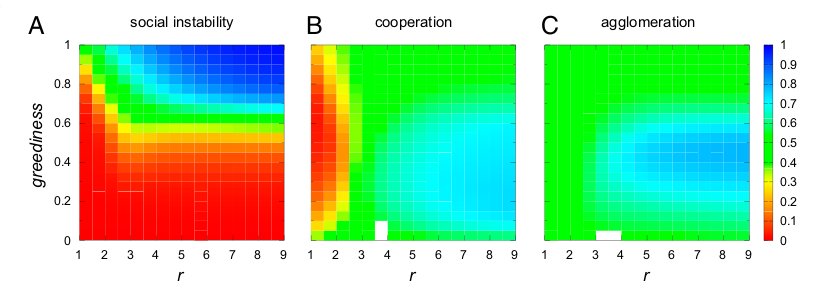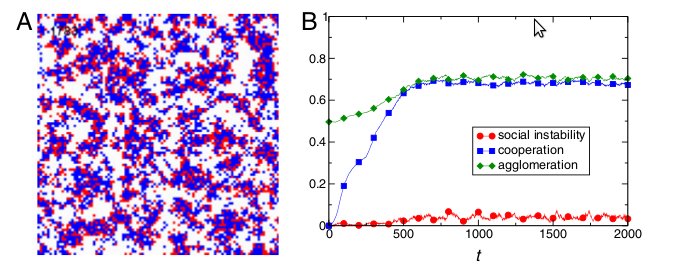No greed no glory, according to the study of Helbing and Roca. Their decision model shows a ‘world’ of greediness, a model promoting cooperation in social dilemma situations, despite very low information requirements while minimizing the influence of imitation, a shadow of the future, reputation effects, signaling, or punishment.
Some interesting quotes:
We find that moderate greediness favors social cohesion by a coevolution between cooperation and spatial organization, additionally showing that those cooperation-enforcing levels of greediness can be evolutionarily selected.
An open translation from a business developers point of view: shaking new hands is necessary and it benefits your orginization when developing within different cooperations at the same time even without ‘shadow of the future’ and ‘reputation effects’.
Note that the initial appearance of cooperation is possible only because of the presence of noise in the decision rule.
Again from a business developers point of view: make some noise.
In comparison, a model society of individuals with low levels of
greediness is unable to realize social benefits. It lacks the drive to
develop effective cooperation and agglomeration, because non-
greedy individuals become easily satisfied with whatever payoffs
they obtain and thus, maintain their strategy and position. In
consequence, neither cooperation nor agglomeration emerges in
such a society. On the contrary, moderate greediness causes
individuals’ dissatisfaction, making them explore other strategies
and/or positions and experience the benefits of being cooperative
in a cooperative neighborhood. As long as those benefits are
sufficient to satisfy individuals’ aspirations, cooperation and ag-
glomeration coevolve and create a stable population with a high
level of cohesion.
Suppose you are a sponsor, business developer or an administrative employee of an NGO, how should you best define greediness, in a positive way for each role? Perhaps in terms of number of reached refugees, growing turnover, number of projects.
Another interesting insight … is that challenging PublicGoodsGames with very low synergy factors … create a stable society, but one that is locked in noncooperative behavior. Defection is, in this case, the only behavior that is compatible with the aspirations of individuals, regardless of their level of greediness.
Ignorance is bliss.

Our results strongly suggest that learning rules, particularly self-referential factors in decision making, can be a key component in the explanation of the emergence and stability of cooperation and agglomeration in human societies.
Individual awareness of spacial (green beard) or temporal (reputation) ‘hotspots’ however seem to make our lives more complex.
So knowing this, what would this mean for the ‘battle of universities’ in the Netherlands? The 3 Universities of Technology have been setting up a collaborative program (examples). Recently the Delft University of Technology (DUT) is also aligning with both the Leiden University and the Erasmus University Rotterdam.
It seems in this case there’s no thresshold to the minimal level of ‘greediness’: the need for lowering costs, balancing out curricula and raising funds. Most recent driver is the necessity of being better visible to the growing market, for instance foreign students (using the Shanghai ranking). This is the hand of ‘the shadow of the future’ (Axelrod 1984): ‘we need to cooperate or else…’.
It would be practical for both strategies (3TU & Delft+Leiden+Rotterdam) when Delft would start sharing it’s tactics because of the conflicting interests in both strategies. Assuming these strategies are not conflicting in near future outcome (at least one established cooperation to survive), at the least they are conflicting because of an indisputable, short term energy drain.
Then again, why give all (in this case both) your cards away?
The study of Helbing and Roca assumes lot’s of possible trade-opportunities, whereas the example of the DUT shows no more than 2 main roadmaps, each summed up by 3 partners. One strategy is based on geographical closeness, the other on similarity in domain.
When not only regarding decision makers, but also lobbyists, employees, media and students, we do have a big number of trade opportunities. This is an analogy where trade opportunites are merely the different perspectives and ‘greedy’ outcomes of individuals and smaller groups.
Here we have a relatively large synergy factor (r) and recentlty (juli and august 2011) a high social instability. Perhaps not from Universities points of view, but indeed from individual perspectives.
Why is my mind wandering off, thinking about Monty Pythons ‘You are all individuals!… …Yes, we are all individuals’?
 Source
Source